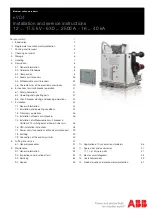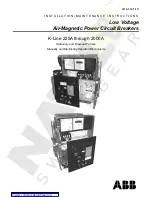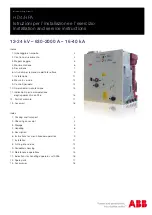
K-Frame Circuit Breaker
Instruction Leaflet for Alarm Switch and Alarm /Auxiliary Switch Combination
WARNING
DO NOT ATTEMPT TO INSTALL OR PERFORM MAIN-
DEATH, SEVERE PERSONAL INJURY, OR SUBSTAN-
TIAL PROPERTY DAMAGE CAN RESULT FROM CON-
TENANCE ON EQUIPMENT WHILE IT IS ENERGIZED.
TACT WITH ENERGIZED EQUIPMENT. ALWAYS
VERIFY THAT NO VOLTAGE
IS PRESENT BEFORE
PROCEEDING WITH THE TASK, AND ALWAYS FOL-
LOW GENERALLY ACCEPTED SAFETY PROCE-
DURES.
ALLEN-BRADLEY
IS NOT LIABLE FOR THE MISAP-
PLICATION OR
OF ITS PROD-
UCTS.
The user is cautioned
to
observe all recommendations,
warnings, and cautions relating to the safety of personnel
and equipment as well as all general and local health and
safety laws, codes, and procedures.
The recommendations and information contained herein
are based on Allen-Bradley experience and judgement,
but should not be considered to be all-inclusive or cover-
ing every application or circumstance which may arise. If
any questions arise, contact Allen-Bradley for further
information or instructions.
1.
INTRODUCTION
General Information
The alarm
switch
(ASL
switch) is
attached to a plug-in module available in the following
combinations (see Fig.
One or two ASL switches
One auxiliary switch and one ASL switch
The plug-in module is mounted in slots in the top of the
trip unit and occupies the accessory mounting cavity in
the circuit breaker frame.
The
ASL
switch provides remote signaling and interlock-
ing when the circuit breaker trips; it consists of one or two
single-pole, double-throw (SPDT) switches. Each SPDT
Fig.
I-
Alarm
Switch
in
K-Frame Circuit Breaker
switch has a make (alarm) and a break (lockout) contact;
it is mounted so that the switch actuator arm is controlled
by the circuit breaker operating mechanism cradle. The
actuator arm extends past the operating mechanism cra-
dle; therefore, only one plug-in module containing an ASL
switch or switches can be used in a circuit breaker.
When the circuit breaker is in the
ON
or
OFF
position, the
cradle holds the make contact open and the break con-
tact closed. When the circuit breaker is in the tripped
position, the make contact is closed and the break con-
tact is open. Any type of trip operation (for example, auto-
matic trip, shunt trip, or undervoltage release) actuates
the
ASL
switch.
The auxiliary switch in the combination accessory indi-
cates circuit breaker contacts status and is used for
remote signaling and system interlocking purposes. Each
SPDT switch has one “a” and one
contact. The plug-in
module mounts in the accessory mounting cavity of the
circuit breaker
so that the switch actuator arm rests
against the molded crossbar. When the molded crossbar
is in the contacts-closed position, the “a” contact of each
SPDT switch is closed and the
contact is open. When
40752-035(1)
Effective 3/02
Bul. 140U


























